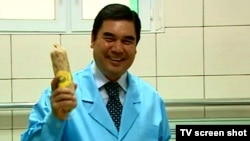Turkmenistan, where praise for the president is always on public display, is about to have a new statue.
For those familiar with the Central Asia country that is probably already enough information.
It’s true. Adored, according to officials, by the Turkmen people, the time has come to have a new statue to President Gurbanguly Berdymukhammedov put up in the capital.
Berdymukhammedov’s predecessor, the late Saparmurat "Turkmenbashi" Niyazov, started the tradition of having statues to honor the president. Niyazov died at the end of 2006 and only one statue to a Turkmen president has been built since, though many of those to Niyazov have been either demolished or removed to less conspicuous areas of Turkmenistan’s cities, towns, and villages.
The language of sycophancy has not been forgotten during that interval and was on display in Turkmen media on July 25.
After a tour of a construction site in Ashgabat and the presentation of plans for the project, Deputy Prime Minister, also Foreign Minister Rashid Meredov told the president, "The high level of development of our country, its successes and achievements, are inextricably linked to the name Gurbanguly Berdymukhammedov."
Meredov, one of the very few, veteran political figures in Turkmenistan, continued, "in the name of the people of the country, of the leaders of [state] structures, [we] appeal to the head of state to decide to establish on one of the beautiful corners of Turkmenistan’s capital, a monument to President Arkadag."
"Arkadag" means "protector" in Turkmen and it is the officially favored address for Berdymukhammedov, as "Turkmenbashi," the "head of the Turkmen," was for Niyazov.
Meredov was quickly followed by Kasymkuly Babaev, the head of the Democratic Party of Turkmenistan (Berdymukhammedov’s party), who added, "From all regions of the country, numerous requests are being received to set up a monument to Arkadag the president…"
"Arkadag" Berdymukhammedov knew the script as well as Meredov and Babaev did. "The people must be consulted on such a question," because, the president said, "The desire of the people is sacred."
Turkmenbashi behaved the same way. Niyazov accepted the will of the people when the Halk Maslahaty, the People’s Council, named him "president for life" in December 1999.
During the following seven years, Niyazov several times raised the issue of stepping down, retiring, and allowing the country to conduct elections for a new president. The People’s Council rejected the idea every time and sometimes officials would even beg him to stay or "scold" him for thinking of shirking the responsibility of leading Turkmenistan’s people. The people loved him and needed him, officials assured.
Early Hopes Dashed
Berdymukhammedov started out with promise. He vowed to undo some of the damaging policies of Niyazov that had led, for example, to serious deterioration in the healthcare and education systems, the near impossibility of movement within the country or travel abroad, and a host of basic human rights and media freedom problems.
Arkadag did relieve some of the difficulties faced in healthcare and education, simply by repealing the changes of his predecessor, but not much else has changed in nearly eight years.
I was in Turkmenistan often in 1992 and 1993. I was in Ashgabat in the summer of 1992 when the statue of Lenin was removed from the central park in Ashgabat. The big Lenin statue in Tashkent (Mustaqilliq Maidoni) had just been taken down (sawn off at the ankles) a few weeks earlier and I was there for that, so Lenin’s statue being dragged away from Ashgabat’s city center seemed to be just part of a trend happening all across the former republics of the Soviet Union.
I visited again shortly after Niyazov’s statue replaced Lenin in Ashgabat’s central park and during succeeding visits I watched as his statues and portraits spread across the country. In April 1993, I went to horse races just outside Ashgabat and was greeted by a massive billboard with Niyazov’s smiling face covering the outer wall of the race track.
The situation in Turkmenistan became stranger and stranger after that and at the center of the weirdness was Niyazov's cult of personality.
This is not the first statue to Berdymukhammedov but this second sculpture reinforces the feeling that the country has not progressed. Niyazov fancied himself an author and even claimed to have penned "Rukhnama," the Book of the Soul that became required reading for everyone in the country to the detriment of mathematics, science, and other disciplines.
Berdymukhammedov has also (allegedly) written several books, some of which are now becoming required reading in schools.
"President" has not been a sufficient title for either Niyazov or Berdymukhammedov and both men surrounded themselves with luxuries few on the planet could imagine while their people suffer through shortages of basic goods and are prevented as much as possible about learning what is happening outside Turkmenistan.
Since the idea was just pitched, publicly, there is still no word about Berdymukhammedov’s pose for the sculpture. The first and currently only public statue to Berdymukhammedov shows him astride a horse.
My choice would be for the statue of Berdymukhammedov to depict the incident in April 2013 when he was catapulted from his horse. He forgave the animal and continues to ride despite the rough fall. There's a positive message there












